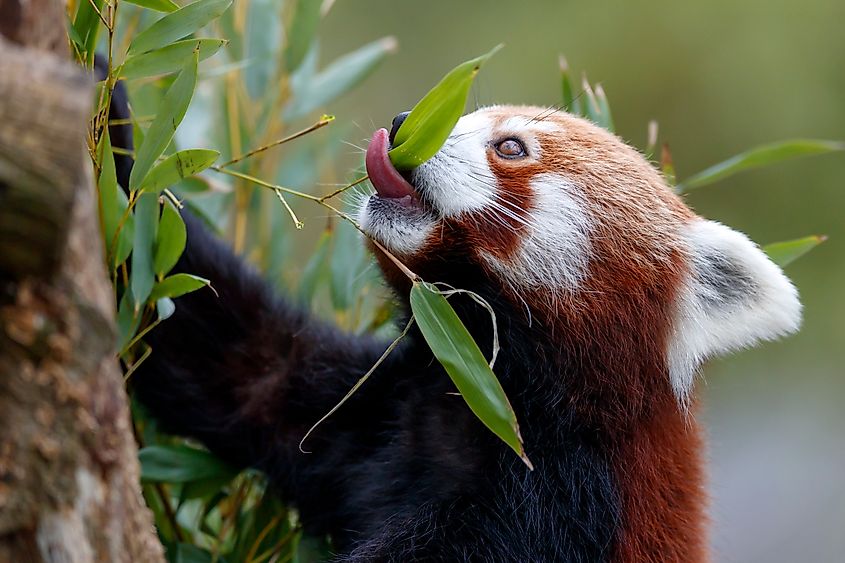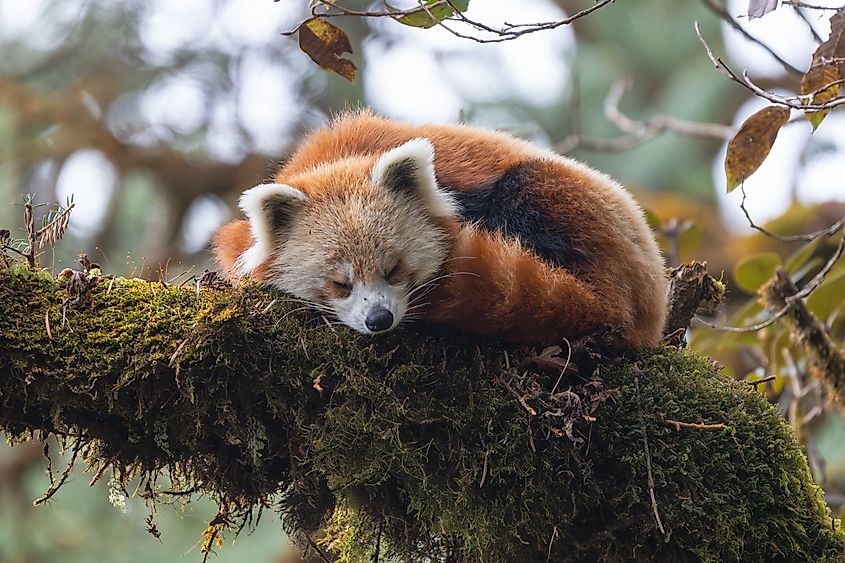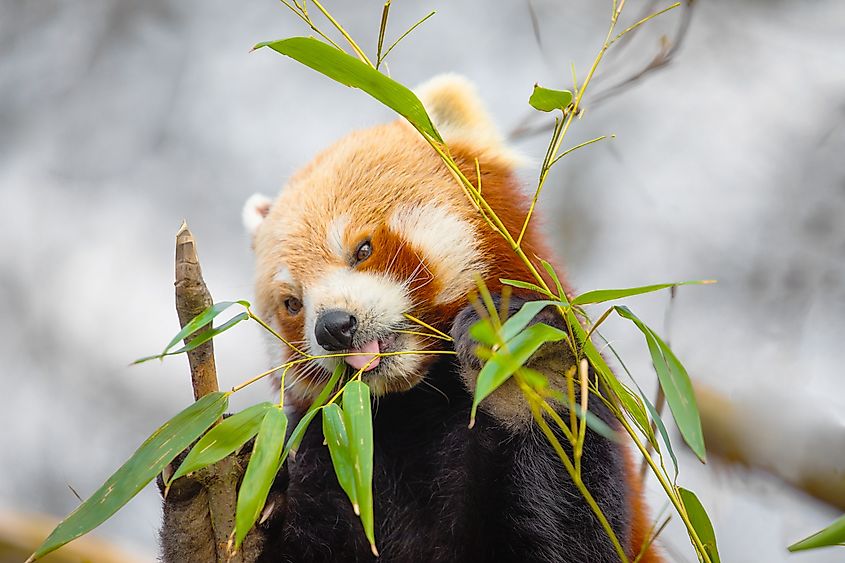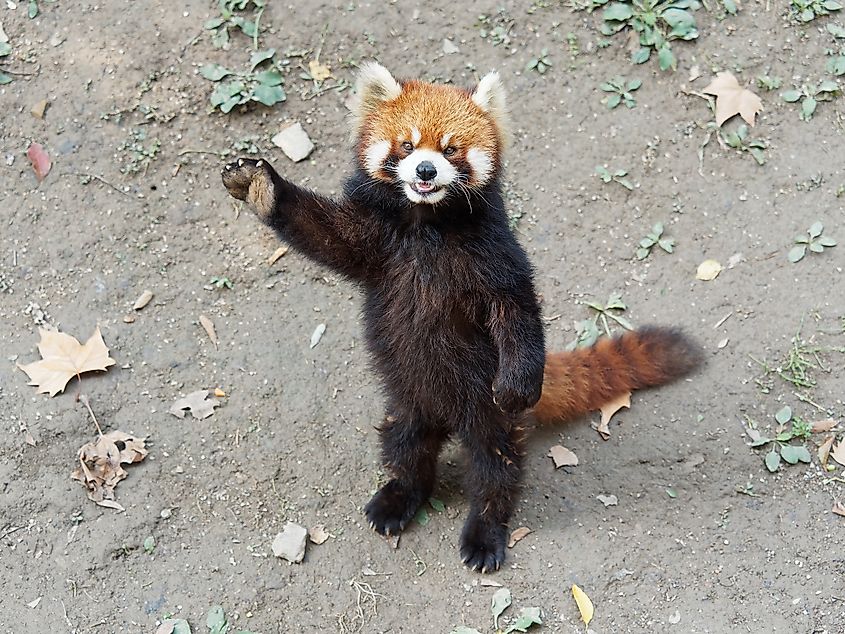
What Do Red Pandas Eat?
- Red pandas are voracious bamboo eaters. Bamboo constitutes 95% of their diet
- They eat food equivalent to up to 20 to 30 percent of their body weight. They eat around two to four pounds or 1 to 2 kilograms of bamboo leaf tips and shoots every single day.
- They have large skulls and molars which makes chewing more efficient. They also have powerful jaws and strong chewing muscles that are adapted to chewing bamboo.
Red pandas belong to the order Carnivora, a diverse group of mammals whose ancestors were mainly meat eaters. Members of this order share certain carnivorous traits, such as sharp teeth designed for slicing through flesh. The red panda, however, has evolved in a different direction. Despite its classification, it feeds mostly on bamboo, relying on a plant-based diet with only occasional insects, bird eggs, or small mammals to supplement its nutrition.
Red Pandas Eat Bamboo

Although the red panda is classified within the order Carnivora, its daily habits tell a different story. Around 95 percent of its diet consists of bamboo, particularly the tender leaves and shoots of mountain species that grow in its Himalayan forest habitat. Its short, strong teeth and powerful jaws help strip the fibrous stalks, but its carnivore-style digestive system extracts nutrients inefficiently, meaning it must eat large quantities—up to 4 pounds (1.8 kilograms) a day. To balance its diet, it occasionally consumes berries, acorns, insects, bird eggs, or small rodents.
At first glance, bamboo might appear to be a poor food choice, but for red pandas it offers a dependable source of nourishment. The plant grows abundantly across the cool, forested slopes of the Himalayas and foothills of China, Nepal, Bhutan, and northern Myanmar, providing an almost constant supply throughout the year. Few mammals can digest bamboo effectively, so red pandas face little competition apart from giant pandas, bamboo lemurs, and bamboo rats. This ready availability helps explain why the species consumes such impressive volumes each day—a topic explored in the next section.
How Much Food Do They Consume?

Red pandas can spend up to 13 hours a day eating to get enough nutrients from bamboo.
Since red pandas can digest only about a quarter of the nutrients in bamboo, they must consume large quantities to survive. An adult red panda spends up to 13 hours a day feeding, stripping and chewing the tender leaves and shoots of bamboo plants. On average, it eats between 2 and 4 pounds (1 to 2 kilograms) of bamboo daily—roughly a fifth of its body weight. Even with such effort, the low-calorie diet leaves little energy for activity, which is why red pandas spend much of their remaining time resting or sleeping in trees.
Although bamboo dominates the red panda’s menu, not every species of the plant suits its taste or nutritional needs. Across its range, as many as 40 types of bamboo grow in the mountain forests, yet red pandas regularly feed on only one or two. In China’s Qionglai Mountains and Wolong Reserve, for instance, about 90 percent of their bamboo diet comes from Bashania faberi, a species that thrives in the cool, misty understory. Still, when bamboo shoots become scarce during certain seasons, red pandas turn to other foods to fill the gap—setting the stage for a more varied, opportunistic diet.
What Are Their Other Food Sources?

Bamboo offers little fat or energy, so red pandas spend much of their day eating or resting to conserve what energy they have. When not feeding, they usually recline along tree branches or curl up to sleep in the cool forest canopy.

A red panda’s diet changes with the seasons—bamboo leaves in winter and fresh shoots in spring.
Their diet shifts slightly with the seasons. In winter, they survive mainly on bamboo leaves, while in spring they prefer the tender new shoots. During autumn, when bamboo growth slows, they add roots, grasses, fruits, and acorns to their meals. They also forage for insects, bird eggs, and grubs, and pregnant females have occasionally been observed hunting small birds, lizards, or rodents for extra protein.
Surviving on such a restricted diet has shaped nearly every aspect of the red panda’s biology. From its specialized teeth and jaw muscles to its false “thumb” that helps grasp slender bamboo stalks, the species has evolved remarkable adaptations for its niche lifestyle. Even its thick fur and bushy tail play a role in conserving energy and thriving in the cold, misty forests it calls home.
Red Panda Adaptations
Although red pandas descend from meat-eating ancestors, their bodies have evolved in remarkable ways to process a plant-based diet. They possess a large, rounded skull and broad molars that make chewing fibrous bamboo more efficient. Powerful jaw muscles and strong bite force allow them to grind the tough stalks for hours each day. Their sharp front teeth slice through bamboo stems, while the molars at the back crush leaves and shoots into manageable pulp.
To handle bamboo with precision, red pandas use curved, retractable claws that help them grasp branches and hold food securely. Most distinctive of all is their pseudo-thumb—an enlarged wrist bone, or radial sesamoid—that functions like an extra digit, enabling them to strip leaves and manipulate bamboo with surprising dexterity.

Beyond their physical traits, red pandas have developed behavioral strategies to cope with their low-calorie diet. In cold weather, they can enter a light state of torpor—slowing their metabolism and waking only a few times each day to feed. To conserve heat, they curl tightly into a ball and wrap their thick, bushy tails around their bodies like blankets. This temperature-regulating behavior helps them endure the freezing Himalayan nights while expending minimal energy.
What Do Red Pandas in Captivity Eat?

In captivity, these same dietary and energy requirements guide how caretakers feed and manage the species. Zoos and breeding centers strive to recreate the nutritional balance and environmental rhythms of the wild, ensuring that red pandas remain healthy and active even far from their native forests.

When available, they receive fresh bamboo leaves and shoots, which remain the foundation of their meals. To ensure proper nutrition year-round, caretakers also provide specially formulated leafeater biscuits—high-fiber, high-protein pellets designed for herbivorous mammals that rely on leafy diets. These supplements supply the essential vitamins and minerals that bamboo alone cannot provide, often accompanied by small portions of fruit to encourage natural foraging behavior.











